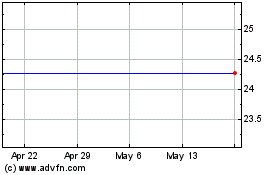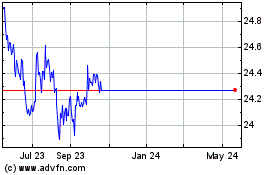China Currency ETFs: Slow and Steady Growth In 2012? - ETF News And Commentary
March 23 2012 - 9:13AM
Zacks
The Chinese economy is the world’s second largest economy and a
key driver of the global economic growth. It amounts to over 10% of
world GDP and about 25% of world GDP growth. Given China’s
importance in the global economy, it appears inevitable that its
currency will become a reserve currency like the Dollar and the
Euro, sometime in future.
Earlier this week, the IMF head stated that Yuan (also known as
Renminbi) could become a global reserve currency if China
implemented market-oriented changes including flexible exchange
rate system, well-developed financial markets and opening up of the
capital account. While China has been slowly loosening controls on
capital flows, its financial markets and exchange rate system still
remain very tightly controlled. (Read: The Guide to China Bond
ETFs)
It has been general belief that China manipulates its currency
to keep it at artificially low levels in order to support its
exports. In July 2005, China removed its decade-old peg to the
dollar, revalued its currency by 2.1% and moved to reference to a
basket of currencies of its major trading partners. The currency
has appreciated roughly 30% against the Dollar since then. China
pegged the currency to the Dollar again in 2008 but returned to
basket based approach in July 2010. While the currency
appreciated 5% against the Dollar in 2011, it has remained largely
unchanged this year.
Recently the World Bank released a report co-authored with a
Chinese cabinet think tank (State Council’s DRC) that outlined
some critical reforms needed in China’s financial markets for
maintaining its growth rate. The fact that the report had official
endorsement implies that the Chinese political leaders are aware of
the necessity to implement reforms. But as the country prepares for
big leadership transition later this year, the reforms may not come
anytime soon. (Read: What Bubble? China ETFs Soaring to Start
2012)
Further, China's capital-intensive and export-oriented economy
is already facing strong headwinds due to economic conditions in
its major export markets. Economists expect China's annual
economic growth to slow to close to 8% in the first quarter of
2012, down from 8.9% in the last quarter of 2011. That would be the
fifth successive quarter of slower growth and China is likely to
end this year with its weakest expansion in a decade.
Last month, China reported its biggest monthly trade deficit
since 1998, with imports exceeding exports by $31.5 billion. Given
the state of economy, the People’s Bank of China is far more likely
to try and keep the Yuan from rising significantly in the next few
months. (Read: Forget FXI, Try These Three China ETFs Instead)
Even if appreciation in the currency is expected to be moderate,
there remains significant attraction in establishing exposure to
the currency of world’s second largest economy and the Yuan
currency ETFs present a great way to playing the growth in
China.
WisdomTree Dreyfus Chinese Yuan Fund (CYB)
CYB aims to achieve total returns reflective of both money
market rates in China and changes in value of the Chinese Yuan
relative to the U.S. dollar. The Fund, which was launched in May
2008, invests in a combination of U.S.money market securities and
forward currency contracts and swaps. It also invests in money
market securities and other instruments, including forward currency
contracts and swaps, denominated in Chinese Yuan that trade and
settle in Hong Kong and other markets outside of mainland China. In
terms of asset groups, T Bills occupy the heaviest weight at 59.5%.
Repos and time deposits follow with 21.7% weight and 18.3% weight
respectively.
The fund had returned 0.52% year-to-date and charges an expense
ratio of 0.45%. The fund however had an attractive distribution
yield of 2.19%, as of the end of last quarter of 2011. Since
inception, it had total returns of 7.26% and currently manages
assets worth $395.6 million.
Market Vectors Chinese Renminbi/USD ETF
(CNY)
Started in March 2008, this fund with AUM at $77.7 million seeks
to replicate, net of expenses, the S&P Chinese Renminbi Total
Return Index. The index tracks the value of the Chinese currency
relative to the U.S. dollar. It follows the value of
non-deliverable, three-month currency forward contracts that are
rolled at three-month intervals and includes daily accrued
interest. The ETNs are senior unsecured debt obligations of Morgan
Stanley. The fund charges 0.55% to the investors and has returned
negative 0.15% year-to-date.
CurrencyShares Chinese Renminbi (FXCH)
FXCH, which made its debut in October last year, seeks to track
the price of Renminbi, plus any accrued interest. The depository
for the trust maintains an account denominated in the Chinese
currency. The interest earned is used to pay the expenses and the
any excess interest in distributed to the shareholders. The fund
charges 0.40% annually to the investors and has returned 0.15%
year-to-date. It has so far attracted assets worth $7.9
million.
FXCH provides investors with direct exposure to the Yuan without
using derivatives and is backed by the underlying currency, held in
deposit accounts. On the other hand, CYB and CNY mostly use
non-deliverable forward currency contracts to gain exposure to the
currency (CYB also invests in some Yuan denominated money market
instruments). As the Chinese currency is rather stable, future
appreciation is usually already priced into the forward contracts,
which results in these two ETFs lagging the currency. FXCH on the
other hand, is more likely to closely track the currency.
To read this article on Zacks.com click here.
Zacks Investment Research
Want the latest recommendations from Zacks Investment Research?
Today, you can download 7 Best Stocks for the Next 30 Days. Click
to get this free report
WisdomTree Chinese Yuan ... (AMEX:CYB)
Historical Stock Chart
From Mar 2024 to Apr 2024

WisdomTree Chinese Yuan ... (AMEX:CYB)
Historical Stock Chart
From Apr 2023 to Apr 2024
